Sous Vide Cooking: JUST COOK!
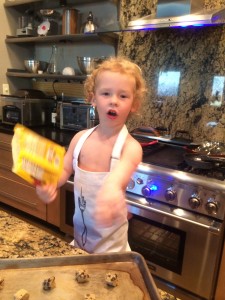
Start cooking young- this is my son in his favorite place- the kitchen.
One thing we have discovered that is the “secret” to weight loss: learning to cook. For many this is intimidating – but when we see patients who are successful five years later, no matter what weight loss operation they had – all of them cook. Why cook? Because they get an appreciation for great food, are able to limit portions, and become truly in charge of what they eat.
COOKING FOR THE BUSY PERSON
While a friend was over, we cooked lamb chops sous vide. Since I had cooked a number of them in the sauce, I was able to put them into the freezer. The other night, after a long work day, the Sous Vide was turned on to 126 degrees and the frozen bags placed into the water oven. In 30 minutes they were ready – giving me time to take a quick shower and change into more comfortable clothes. It took three minutes to cook some green beans and we had a delicious meal of lamb chops tandoori with green beans.
Unlike a microwave the water oven gently re-heats the proteins, allowing them to not lose moisture. If you have ever re-heated chicken in the microwave it comes out dry as plywood. The microwave is great for steaming vegetables, making popcorn, but for re-heating most meats it falls short as it re-heats by exciting the water molecules in the proteins – thus drying them out.
YOU CANNOT OVERCOOK IN THE SOUS VIDE
Did you ever overcook food? Ever have Thanksgiving turkey that was so dry you had to slather it with gravy just to get it down? With a conventional oven, the temperature is set typically around 350 degrees F. But you only want the meat to cook to about 160 degrees (at the most) – because otherwise it will dry out from over cooking. The Sous Vide water oven is preset to a temperature (148 for turkey) – so the food will never go beyond that temperature and therefore not overcook.
The reason the meats become dry is that the proteins are overcooked. Proteins that commonly dry out from over cooking include: eggs, chicken, steak, duck, and pork. Proteins, under a microscope, look like a slinky, with water molecules in the middle of them. When heated the slinky opens up, allowing the water to escape. Proteins release their liquid when they reach a temperature of 160 degrees F or higher. When these proteins lose their moisture they can easily become dry, tasteless, and can cause problems with getting stuck in the esophagus – a food bolus- and a trip to the emergency room. For my patients who have a Laparoscopic Adjustable band- these proteins can be too dry to pass through the band- so they become stuck there.
In the video you will see us making two New York Strip Steaks using Sous Vide style- the steaks made four meals – and one of the people who ate them had a Lap-Band. She was able to eat the steak with no problem as it was made with the Sous Vide style.
Think about chicken that is cooked in a conventional oven at 350 degrees Fahrenheit. Most recipes say to take the chicken out of the oven once the internal temperature is 160 degrees. This means it will continue cooking after you take the chicken out of the oven- meaning it will dry out.
If you leave the chicken in the oven too long it is quickly over-cooked, and dry. If you try to swallow a large piece it just doesn’t go down easily. That same chicken breast, if cooked Sous Vide is cooked at a temperature of 148 degrees Fahrenheit in a sealed bag. If the chicken is left in too long it will not go above 148 degrees. The chicken is still being cooked at a temperature where the proteins keep their moisture. When you bite into Sous Vide cooked chicken it will feel moist, tasty, and retain a lot of great flavor.
Eggs also can be over cooked , because eggs are mainly protein. So if the eggs are cooked at too high a temperature they will lose their moisture and be dry. Sometimes people call them “rubbery.” Sous Vide eggs are delicious- while they take a while to cook, about an hour, when they come out they will have a creamy white and creamy yolk. Most eggs cooked in restaurants are cooked hot and fast on a hot grill, at temperatures that cause the proteins to dry, leaving the eggs rubbery, and hard to choke down. I like to share my sous vide recipe for eggs, as I think sous vide is the best way to cook them.
I love Sous Vide cooking because I can get reliable steak, chicken, turkey (the moistest holiday turkey), and amazing eggs. On any given week we will have Sous Vide lamb, steak, chicken, or salmon – eating by this method three to four times a week because it is just easier.So I’ve spent the last few years perfecting a few recipes with Sous Vide. We have a number of recipes on TerrySimpson.com.
WHERE TO BUY
The Sous Vide cooking requires several parts. All of which are available by purchase from fine food stores, like William-Sonoma, or Sur Le Table. We have also found them in Costco, and in various on-line places. Even Amazon has them.
The Food Sealer:
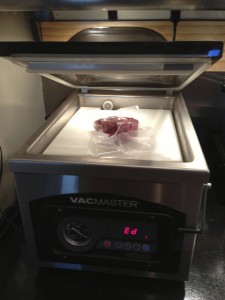
The chamber sealer works very well
A chicken breast has been seasoned and is in the vacuum sealer. Food is placed in a plastic bag, then the air removed and it is sealed. There are several systems that do this. Most Sous Vide cooking sets come with these, but you can some great ones on-line.
The food is placed into a plastic bag, and the food sealer will remove the air and then seal the bag. The food then has only the plastic bag between it and the water. This allows the water to uniformly heat the food on all surfaces. The sealer below uses a re-usable bag, and the machine removes the air from the bag. There are many types of these devices available.
These food sealers are used for more things than Sous Vide Cooking – the ability to remove air and seal food allows for longer preservation of almost all foods. Sous Vide bags are often much less expensive than standard re-sealable bags, like Zip-lock, so I use my food sealer when I need to reseal other foods. Many companies sell both the water oven as well as the food sealer in a set.
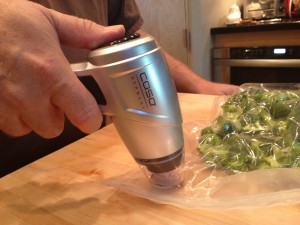
Portable sealers to vacuum seal the food are also available.
You can get some very expensive models that cost hundreds of dollars, or spend less money for a hand-held, as shown, or other types like the food-sealer.
For starting out, I recommend getting a simple food sealer such as the kind that go with your Sous-Vide set. I use Sous Vide cooking 3-4 times a week in our house, and we ultimately purchased a “commercial grade” vacuum seal device.
However, some on a budget, will use zip lock bags and get the air out.
The Water Oven
This is the water bath unit I use – it is made by Polyscience, and attaches to any pot, or to a large tube like this one. They can be found on-line or from William-Sonoma. Polyscience was the first company to make these units available to the home cook.
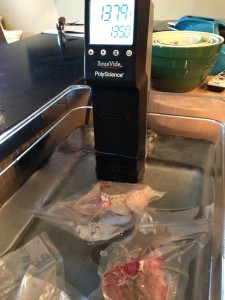
This is an emersion unit for Sous Vide- made by Polyscience
The water oven keeps the temperature of the water within a tenth of a degree, and keeps the water circulating.
The water oven is simply a device that keeps water temperature constant, within a tenth of a degree. Fill the tank with water, set the temperature, and let the water warm up and they will maintain that temperature for as long as you want it. Most foods will only require an hour or so.
Many of my patients are quite happy with water oven made by Sous Vide Supreme. That system is more of a set size box. It is a good starter unit.
Once you have the food in your vacuum sealed container, and the water-oven set you put the bags into it and wait. The time and temperature are available on our website and soon our cookbook for most cuts of meats.
Sous Vide also works great for vegetables. Allowing the vegetables to maintain their color and texture, but breaking down the fiber gently.
Perhaps my favorite way to cook eggs is using Sous Vide. The egg doesn’t need to be placed into a plastic bag, because it already comes in a shell! If you cook the egg Sous Vide style, it comes out with a perfect creamy yolk, as well as a creamy egg white which is better than any egg you can get anywhere.
While the water oven is a great way to get and keep food- some people don’t have it in their budget. So some people use a “cooler.” By putting hot and cold water to get to the temperature you need, you can place your food in and allow it to cook Sous Vide style. Just keep an eye on the temperature and add hot water or cold water as needed.
You Don’t Have To Buy To Test
The units have come down in price- the immersion units are now around $169 at Amazon for the Anova immersion unit. Some people have even converted slow-cookers to operate Sous Vide, or rice-cookers to be a water oven. There are plenty of those instructions on YouTube and elsewhere on the internet. As you can see we even made a video about hacking the Sous Vide system staring our son, JJ.
On The Horizon
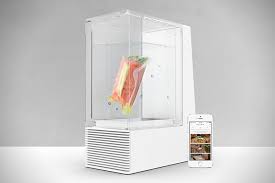
This machine comes with the ability to cool, it can be programmed from your app, and you can reset at anytime.
New Sous Vide units are coming out, like the one from Mellow that have a refrigeration side as well as the ability to turn on and off via an app on your phone. This means you can put some salmon in before you leave for work- it will keep it cool, and then start warming and have it ready when you want it. You might consider pre-ordering this new smart sous vide.
Food Safety
Cooking at low temperatures makes some people nervous about food-borne illness. Sous Vide has been studied extensively and is safe to cook the foods at these low temperatures for the times we state.
Salmonella is one of the worst bacterial food-borne illness we read about today. It is responsible for a number of hospitalizations and even deaths. We hear about it in eggs, produce, chicken meat, and turkey meat. It is important when handling raw eggs, raw meat, raw chicken, raw turkey, or any raw foods to consider them contaminated.
Heat kills Salmonella, but Salmonella thrives at certain temperatures. Below 40 degrees Fahrenheit Salmonella reproduces very slowly. This is why we keep food in the refrigerator until we are ready to use it. At room temperature, 70 degrees Fahrenheit (76 for my wife), Salmonella reproduces about every twenty minutes. This means in two hours, food left out may be contaminated to the point where it will cause severe and deadly food poisoning. Above 122 degrees Fahrenheit no bacteria can live and reproduce, and most of them are killed. The way to remember it is your body temperature is typically 98.6 degrees Fahrenheit- a perfect temperature for you and Salmonella. Any temperature you feel comfortable in so will Salmonella.
Bacteria Time and Temperature:
Pasteurization refers to a process of heat and time that will kill bacteria. The higher the heat, the less time that it takes to kill the bacteria. This is the process used to treat milk and juices. When we cook at high temperatures we can kill the bacteria quickly, however the food becomes dried out and easily stuck above a band and looses flavor.
With chicken cooking above 130 degrees for the Salmonella are unable to grow at those temperatures, as are all the other common bugs. Still, food safety is important. Wash hands after handling raw meats- wash all surfaces and utensils after they come in contact with raw meat. It is more likely that the raw meat will contaminate those surfaces and that those surfaces will pass the bugs onto other foods than you becoming sick from the meat directly. We cook our chicken at 148 degrees F for at least 35 minutes.
For beef- the FDA states that beef is safe when it is held at 130 F for 112 minutes or 140 for 12 minutes. The temperature of a rare steak is between 130 and 139 in the center. By cooking the steak for 45 minutes at 136 degrees you will keep well within the recommended limits.
For chicken the FDA states that it is safe when it is held at 165 degrees for a few seconds, but also at 148 degrees for seven minutes. Traditional cooking of chicken to 160 degrees Fahrenheit means that the majority of the chicken is over cooked. Sous Vide has the advantage of holding the meat at a specific temperature for the time needed. Lower temperatures allow the chicken to retain its taste. We cook chicken at 148 degrees for 35 minutes. Although the great thing is that if you leave the chicken in the water bath for longer, it won’t overcook — the temperature is held constant.
Plastic – is that safe to cook in?
Yes – this also has been tested extensively. In fact, we discuss the safety of cooking in plastic bags in previous articles.
The Best
Cooking Sous Vide is the way to cook if you have a band, or even if you don’t. We love cooking this way. It is fool-proof, delicious, and keeps food moist.
